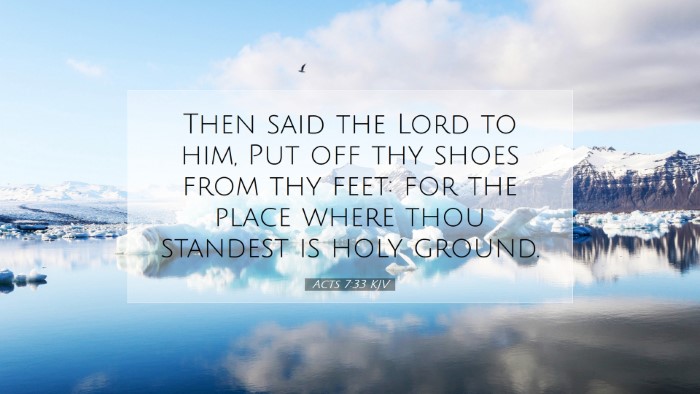Commentary on Acts 7:33
Acts 7:33 states, "Then the Lord said to him, 'Take off your sandals from your feet, for the place where you are standing is holy ground.'
This moment is pivotal in the narrative of God's interaction with His people through Moses. Various public domain commentaries provide profound insights that are crucial for pastors, students, theologians, and Bible scholars to consider. Below, we summarize key insights from Matthew Henry, Albert Barnes, and Adam Clarke regarding this significant verse.
1. Historical Context
This verse occurs within Stephen's speech to the Sanhedrin, where he recounts the history of Israel. It illustrates God’s call to Moses from the burning bush and emphasizes the sanctity of God's presence.
2. The Holy Ground
-
Matthew Henry: Henry emphasizes the importance of the ground being called holy. He notes that it is not merely the physical location but the divine presence that sanctifies it. When God instructs Moses to remove his sandals, He signifies that proximity to Him demands holiness and reverence.
-
Albert Barnes: Barnes elaborates that the removal of sandals symbolizes humility and submission to God's authority. It is a physical act reflecting a spiritual reality—recognition of God’s holiness and man's unworthiness. The command serves as a reminder of the sacred spaces in our lives where we meet God.
-
Adam Clarke: Clarke points out that the act of removing sandals was common in ancient Near Eastern cultures as an expression of respect. He stresses that this act is universally understood as a recognition of the divine, underlying the principle that any encounter with God should provoke a sense of awe and humility.
3. God’s Revelation
The holy ground symbolizes God’s revelation of Himself to humanity. In the context of Moses, it is a divine encounter that initiates the Exodus narrative. Each commentator notes the significance of God making Himself known in a common place—in this case, a desert.
-
Matthew Henry: He highlights that God's methods of calling His servants often involve ordinary circumstances made extraordinary by His presence. He calls attention to the need for a response of faith when confronted by God’s holiness.
-
Albert Barnes: Barnes provides insight into how God's self-revelation serves a dual purpose; the reminder of His holiness and the call to obedience. For Moses, the sandals were not merely an issue of physical cleanliness but respect for the divine.
-
Adam Clarke: Clarke notes that this moment serves to lay the groundwork for Moses’ future leadership. By instructing Moses to take off his sandals, God signals the importance of preparation for the work ahead and the necessity for Moses to be transformed by this experience.
4. Application for Believers Today
The directive to remove shoes serves as a metaphor for the call to live in holiness before God. It challenges modern believers to consider their own lives and the spaces in which they encounter God.
-
Matthew Henry: He encourages believers to maintain a posture of reverence in their worship and daily life, reminding them that encountering the divine requires a commitment to holiness.
-
Albert Barnes: Barnes underscores that removing one’s sandals can signify letting go of personal pride and the distractions of the world, which hinder a true relationship with God. Believers are called to approach God with humility, recognizing His sanctity.
-
Adam Clarke: Clarke urges believers to reflect on the areas in life where they need to acknowledge God's holiness. This act of removing sandals symbolizes a deeper cleansing within that allows for true communion with God.
5. Theological Significance
In theological terms, this verse encapsulates the broader theme of God’s holiness contrasted with human sinfulness. It illustrates the chasm between the divine and human experience, and yet shows God’s desire to bridge that gap through His call.
-
Matthew Henry: He asserts that this moment in Acts is a foreshadowing of the greater work of Christ, who made a way for humanity to approach God directly. The holiness demanded of Moses prepares the reader for understanding the holiness required of all followers of Christ.
-
Albert Barnes: Barnes reflects on the continual need for holiness in the lives of believers, inspired by the encounter Moses had. He discusses the implications of God's holiness in the New Testament context, where believers are called to be holy as He is holy.
-
Adam Clarke: Clarke connects this command to remove sandals to Jesus' teaching on humility and servanthood. The act serves as a reminder that, in households of faith today, humility is key when approaching God and His commands.
Conclusion
Acts 7:33 reveals not just the narrative of Moses but sets the foundation for understanding God's holy character and the reverence He demands. The insights provided by Matthew Henry, Albert Barnes, and Adam Clarke unveil layers of meaning concerning call, holiness, and the transformative power of God’s presence. As modern believers engage with scripture, this verse serves as a critical reminder to approach God with humility, recognizing the sacredness of His call and the holy ground upon which they stand.


